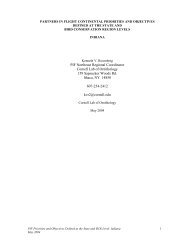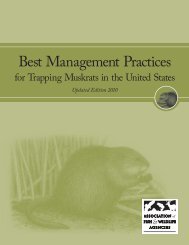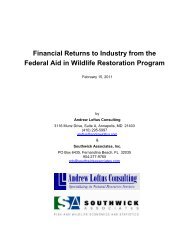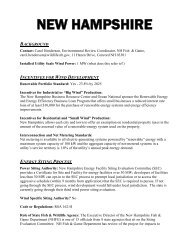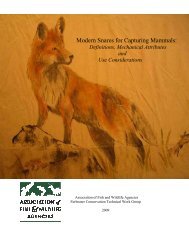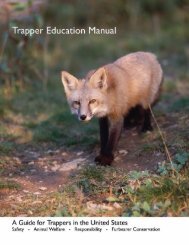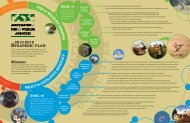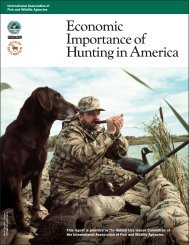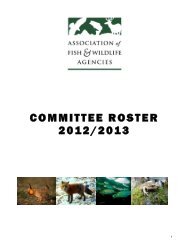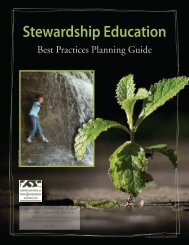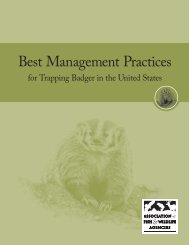Southern Wings Vision 2012
Southern Wings Vision 2012
Southern Wings Vision 2012
You also want an ePaper? Increase the reach of your titles
YUMPU automatically turns print PDFs into web optimized ePapers that Google loves.
www.fishwildlife.org • 2
Contents4 EXECUTIVE SUMMARY6 INTRODUCTION8 VISION & MISSION8 <strong>Vision</strong>9 Mission12 BACKGROUND14 TARGETS, GOALS, & OBJECTIVES14 Targets16 Goals & Objectives20 LEADERSHIP & IMPLEMENTATION22 EVALUATION AND MONITORING28 PROGRAM OPERATIONS30 REFERENCES31 ACRONYMS32 APPENDIX I:Organizational chart for <strong>Southern</strong><strong>Wings</strong>33 APPENDIX II:<strong>Southern</strong> <strong>Wings</strong> project locationsfrom 2009 - <strong>2012</strong>www.fishwildlife.org • 3
ExecutiveSummaryThe state fish and wildlife agencies share migratory birds not only with each other but with othercountries across the globe. Partners in Flight Saving our Shared Birds report acknowledges thatalmost half of the native landbirds (418 species) in North America rely on habitats in at least 2 ofits 3 countries—United States, Canada, and Mexico (Berlanga et al. 2010). Eighty percent of allshorebirds breeding in United States, Canada, and Mexico are also shared among the threecountries. Neotropical migrants travel hundreds and even thousands of miles between breeding andwintering grounds and depend on habitats throughout their entire journey. Their conservationcannot be accomplished in one park, one country, or in some cases, even on one continent. Itdepends on the collective partnership of conservationists across the Western Hemisphere. Birds arenot aware of political borders, but their challenges transcend these boundaries and so must ourplanning and initiatives on their behalf.Birds are also indicators of the health of our ecosystems. The 2009 State of the Birds Report(NABCI 2009) provided the first comprehensive, national look at how birds are faring across majorbiomes. The report identified concerns for many species. For example, there is high concern forcoastal shorebirds because of dwindling food supplies and disturbance of their habitats. Dramaticdeclines in grassland birds highlight both the loss and degradation of one of our most endangeredhabitats. Grasslands are also our only tri-national terrestrial habitat in North America and requirewww.fishwildlife.org • 4
cooperation among countries to conserve shared species.Amidst all of this, birds are one of our most cherished resources. They are photographed,watched, hunted, fed, and enjoyed by millions of Americans. In 2006, there were over 48 millionbirdwatchers or birders in the U.S. Birders spent an estimated $12 billion on trip expendituresand $24 billion on equipment expenditures and generated over $82 billion in total industry output(Carver 2009).To sustain healthy bird populations into the future, state wildlife agencies and their partnersspend substantial amounts of money managing habitat, monitoring species status, conservinghabitat, and educating the public. However, they recognize that, as a shared resource, theirinvestments within our borders are not enough. To protect the tremendous conservation actionswithin their states, state wildlife agencies can work through the <strong>Southern</strong> <strong>Wings</strong> Program, onemechanism to build partnerships and support ongoing bird conservation projects in Mexico,Central America, South America and the Caribbean. <strong>Southern</strong> <strong>Wings</strong> seeks to work with ourconservation colleagues in these regions and support their efforts to benefit the conservation ofmigratory birds linked to the individual states. Our partners are equally passionate, dedicated,and knowledgeable about the needs for conservation of our shared migratory birds.Since 2009, the <strong>Southern</strong> <strong>Wings</strong> Program has been the mechanism to help facilitate state wildlifeagency involvement in these projects. In the first 2 years, state agencies and their U.S. partnershave contributed over $250,000 that was then matched before contributing to an on-the-groundproject. Projects with Mexican and Colombian partners have helped state fish and wildlifeagencies support the management of grasslands in Saltillo, tropical woodlands in the YucatanPeninsula, and wetlands in the Colorado River Delta in Mexico; the conservation of Andeanforest in Colombia and priority habitats in Nicaragua and much more. All of these projects are incritical areas for priority migratory bird species such as Cerulean Warblers, Golden-wingedWarblers, and Long-billed Curlews.This document provides the vision to move the <strong>Southern</strong> <strong>Wings</strong> Program forward over the next10 years. The goals are as follows.www.fishwildlife.org • 5
I. Fifty states contribute resources to, and participate in, the <strong>Southern</strong> <strong>Wings</strong> Program.II. By 2022, $2 million is invested annually by states in <strong>Southern</strong> <strong>Wings</strong> projects.III. By 2022, sixty state agency priority migratory bird species have benefited from <strong>Southern</strong><strong>Wings</strong> projects through land conservation and acquisition, management to improvehabitat, outreach to private landowners and cooperators, and government and landownersupport for conservation of important habitats.IV. By 2022, twenty-five formal partnerships between state wildlife agencies and Mexico,Central America, South America and Caribbean partners are established and supportsuccessful implementation of <strong>Southern</strong> <strong>Wings</strong> Program projects.V. By 2022, twenty-four project areas have been or are being supported by the <strong>Southern</strong><strong>Wings</strong> Program.VI. By 2022, communication and information exchange is occurring among participatingstate wildlife agencies and between agencies and Mexico, Central America, SouthAmerica and Caribbean partners.The goals have associated objectives that are also measurable and achievable. The <strong>Southern</strong><strong>Wings</strong> Leadership Team will define specific strategies to achieve the goals and objectives overthe short and long term. The state agencies involved in the <strong>Southern</strong> <strong>Wings</strong> Program, the BirdConservation Committee, and the <strong>Southern</strong> <strong>Wings</strong> Program’s Leadership and TechnicalCommittees will employ this collective vision to reach out to other state wildlife agencies andpartners that want to participate in the conservation of our shared migratory bird resource.www.fishwildlife.org • 6
IntroductionNeotropical migratory birds face unprecedented threats. Greatest among them is habitat loss. To protect in-stateconservation investments for migrant birds, conservation actions should be implemented across their full annualcycle. <strong>Southern</strong> <strong>Wings</strong> facilitates the use of state fish and wildlife agency contributions from Mexico and theCaribbean to the southern cone of South America. <strong>Southern</strong> <strong>Wings</strong> and its non-governmental organizationpartners help to focus vital conservation activities on winter refuge sites for more than one-half of NorthAmerica’s breeding birds; such sites include forests, wetlands, and grasslands that face continually mountingpressures. The anticipated loss of remaining habitats due to expected human population increases over the next40 years casts an air of uncertainty over the future of all wild places and species dependent on them, includingneotropical migratory birds. Populations of migrants are much more concentrated on the winter grounds, making threatsto nonbreeding grounds of high concern since they can have a disproportional impact on a species and making conservationto protect or improve nonbreeding habitat good investments. Habitat conservation and management throughout the fullannual cycle of birds, and especially the state’s priority species is a prerequisite to ensuring our in-stateconservation efforts are protected.It is not sufficient to focus limited resources solely on breeding ground issues in the United States. Conservationactions to stem the widespread decline of birds with far flung geographies require a hemispheric approach. Asstate wildlife agencies, we must scale up bird conservation initiatives through the implementation of strategiesthat span continents. The <strong>Southern</strong> <strong>Wings</strong> Program (<strong>Southern</strong> <strong>Wings</strong>) is designed to do just that.www.fishwildlife.org • 7
Born of need and rooted in the recognition that wintering ground conservation is an essential component of theever evolving bird conservation paradigm, <strong>Southern</strong> <strong>Wings</strong> provides a vehicle to conduct full annual-cycleconservation action for our priority bird species (e.g., Species of Greatest Conservation Need as identified in theState Wildlife Action Plans) through conservation action in stopover and wintering sites. Modeled after the stateinvolvement in the North American Waterfowl Management Plan and North American Wetlands ConservationAct in Canada, <strong>Southern</strong> <strong>Wings</strong> sets the stage for international collaboration through establishment of a programthat facilitates state fish and wildlife agencies’ ability to work directly with colleagues beyond our state andnational borders to generate benefits to state priority species. By advancing protection and management ofwintering ground habitat critical to the long-term survival of our shared migratory bird heritage, <strong>Southern</strong> <strong>Wings</strong>heralds a new era of bird conservation for many state wildlife agencies and protects our state-level investment inbird conservation.An evolving program, <strong>Southern</strong> <strong>Wings</strong> requires a vision that provides future direction; guides the work of thecoordinator, the Leadership Committee, and the Technical Team; clarifies the niche the <strong>Southern</strong> <strong>Wings</strong> fillsamidst other international bird conservation efforts; and provides specific guidance to advance the <strong>Southern</strong><strong>Wings</strong>. This Strategic <strong>Vision</strong> document meets these purposes. The document builds on the successes of <strong>Southern</strong><strong>Wings</strong>’ first 2 years and leads the program into the future. It also builds on the basic principles that migratorybirds are a shared resource and that conservation of migratory birds requires conservation built on sound sciencethroughout their full annual cycle.www.fishwildlife.org • 8
Mission &<strong>Vision</strong><strong>Vision</strong>Healthy and sustainable populations of migratory birds throughout the Western Hemisphere that are enjoyed forgenerations to come.MissionEncourage and facilitate state fish and wildlife agency participation in conservation projects for shared prioritybirds in Mexico, Central America, South America and the Caribbean.www.fishwildlife.org • 9
www.fishwildlife.org • 10
BackgroundStemming from a September 2005 presentation by the Missouri Department of Conservation at the Partners inFlight (PIF) Implementation Committee meeting, the idea of a mechanism to support state participation inconservation in Mexico, Central America, South America, and the Caribbean was born. At the September 2007Association of Fish and Wildlife Agencies (AFWA) meeting, the <strong>Southern</strong> <strong>Wings</strong> Task Force (Task Force) wascreated and given the specific charge “to create a funding mechanism that provides an easy and flexible avenuefor states willing to participate in conservation in Latin America and the Caribbean by contributing fundsannually through a U.S.-based third party that will handle the funds and coordinate the distribution of funds.”The Task Force presented an interim report including recommendations to the Partners inFlight/Shorebird/Waterbird Working Group and then to AFWA’s Bird Conservation Committee in March 2008.The report framed the preliminary guidance for <strong>Southern</strong> <strong>Wings</strong>, characterized the opportunities and challengesassociated with <strong>Southern</strong> <strong>Wings</strong> implementation and identified four implementation alternatives.The guidance stated that a mechanism should be 1) based solidly on the biological connection that exists betweenmigratory birds that occur in the states and also spend part of their annual cycle in Mexico, Central America,South America, and the Caribbean, 2) allow for relatively easy and seamless financial participation by interestedstates, 3) report to those states on progress and accomplishments, and 4) achieve the benefits of match andleverage of state funds.www.fishwildlife.org • 11
During report preparation, the Chair of the Bird Conservation Committee queried states via letter regarding theirinterest in <strong>Southern</strong> <strong>Wings</strong> participation. Of the 21 states that responded, 18 indicated willingness to participate,including 6 who stated current funding levels preclude immediate participation. The responses also indicatedmost states were comfortable pooling money for regional projects; all states would require some type of reportingon project accomplishments; and that overhead charges should be below 20%. Additionally, the WesternAssociation of Fish and Wildlife Agencies, Southeastern Association of Fish and Wildlife Agencies, andMidwest Association of Fish and Wildlife Agencies offered to invoice, collect, hold, and disseminate funds forparticipating member states. In general, the responses indicated broad support for <strong>Southern</strong> <strong>Wings</strong> development.Recognizing that internationally-supported waterfowl conservation efforts in Canada began with only 3participating states, the Task Force recommended the development of the <strong>Southern</strong> <strong>Wings</strong> Program. In 2009, the<strong>Southern</strong> <strong>Wings</strong> Program was officially endorsed by AFWA and began accepting voluntary contributions.As is so well demonstrated by the North American Waterfowl Management Plan (NAWMP), sound science isneeded to put good conservation on the ground especially for migratory birds that require action at breeding,stopover, and wintering sites. PIF, the U.S. Shorebird Conservation Plan, and Waterbirds Conservation for theAmericas continue to improve the science behind migratory bird conservation across the Western Hemisphere.PIF was instrumental in developing the foundation for states’ linkages to their partners to the south. PIF createdmaps depicting the linkages between states and wintering grounds for migratory birds important to individualstates; they developed the tri-national assessment and corresponding report; and they facilitated numerousdiscussions on the importance of international conservation efforts. The U.S. Shorebird Conservation Plan, theWestern Hemisphere Shorebird Group, and the Western Hemisphere Shorebird Reserve Network support andencourage research to further our knowledge of critical areas for the conservation of shorebirds. The Waterbirdsfor the Americas partnered with Birdlife International to identify important waterbird sites in Central and SouthAmerica. In addition, monitoring stations and bird banding data continue to improve our knowledge throughoutthe annual cycle of bird migration. The wealth of information available allows <strong>Southern</strong> <strong>Wings</strong> to identifyprojects that support state agencies’ priority migratory bird species.www.fishwildlife.org • 12
Throughout the development of <strong>Southern</strong> <strong>Wings</strong>, non-governmental and federal partners provided insight andsupport and facilitated development of <strong>Southern</strong> <strong>Wings</strong>. <strong>Southern</strong> <strong>Wings</strong> requires support to move funds topartners and to provide the accountability needed for the states to send money to out-of state partners. Statewildlife agencies can move money directly to a partner in Mexico, Central America, South America and theCaribbean; through a State Regional Association; or through a third party organization. The third party nongovernmentalorganization (NGO) contracts with the partners, ensures that projects are advancing, keeps track ofbudgets and match, and provides reporting twice a year to allow states to know where and how their funds arespent. In the inaugural year of the Program (2009-2010), seven states contributed more than $75,000. In thesecond Year (2010-2011), 10 individual states and the 13 states of the Northeast Association of Fish and WildlifeAgencies (NEAFWA) contributed $128,500 and raised an additional $48,400 from partners. To date, 11 statesand their partners have already recommitted over $187,000 for 2011-<strong>2012</strong> (see Figure 1).State wildlife agencies decide what projects they will support and have complete control of the amount of moneythat they contribute to the <strong>Southern</strong> <strong>Wings</strong>. In the first 3 years, states annually contributed between $1,000 and $30,000. The <strong>Southern</strong> <strong>Wings</strong> ensures that all state funds receive at least a 1:1 match and ideally more. The abilityto provide such a match comes both from our NGO partners and from partnering with the Neotropical MigratoryBird Conservation Act (Neotrop Act). A majority of <strong>Southern</strong> <strong>Wings</strong> projects to date have a connection to theNeotrop Act, which has a 3:1 match requirement.<strong>Southern</strong> <strong>Wings</strong> is one of many efforts working internationally to conserve birds. Others include, but are notlimited to, the Neotrop Act, U.S. Forest Service International Programs, U.S. Fish and Wildlife Service (USFWS)Division of Migratory Birds, USFWS International Conservation, National Audubon’s International AlliancesProgram, The Nature Conservancy, and several Bird Habitat Joint Ventures. The number of engaged programs isan indication of the demand for the international conservation cooperation necessary to adequately conservemigratory birds. Another indication is the level of funding requests received by the many programs. In the first 10years of the Neotrop Act, the average annual funding request was $12,730,000. The <strong>Southern</strong> <strong>Wings</strong> fills aunique niche by facilitating state wildlife agency’s direct participation in neotropical migratory bird conservationon critical wintering habitat. This allows for conservation action on state agencies Species of GreatestConservation Need during times and in locations that might otherwise be considered out of the scope of the statewildlife agencies. <strong>Southern</strong> <strong>Wings</strong> also allows state wildlife agencies to match the dollars they contribute andpool their funds with other state wildlife agencies where appropriate. Considerable actions and expenditures onwww.fishwildlife.org • 13
eeding ground may be ineffective without supporting conservation action on winter grounds. Even relatively smallamounts of money can go a long way and target especially critical needs for the species in most need of assistance.Figure 1: Contributions to the <strong>Southern</strong> <strong>Wings</strong> Program as of August 2011 (note that year 3 funds arecontinuing to be collected)www.fishwildlife.org • 14
Targets,Goals, &ObjectivesTargetsTargets represent the overall desired condition that the <strong>Southern</strong> <strong>Wings</strong> seeks to achieve.T1. Sustainable populations of migratory birdsT2. Fifty states participating in the <strong>Southern</strong> <strong>Wings</strong> ProgramT3. Annually increasing contributions to support critical projects facilitated through the <strong>Southern</strong> <strong>Wings</strong>ProgramT4. <strong>Southern</strong> <strong>Wings</strong> Program support to critical projects.T5. Enhanced relationships between state wildlife agencies and Mexico, Central America, South America andCaribbean partnersT6. States and project partners support annual-life cycle conservation of shared speciesGoals & ObjectivesThe goals lay out our long-term plan. Each goal is 1) linked to targets, 2) impact oriented, 3) measurable, and 4)time limited (generally >10 years). The objectives are 1) results oriented, 2) measurable, 3) time limited(generally 3-10 years), 4) specific, and 5) practical. Each objective defines in specific terms what the <strong>Southern</strong><strong>Wings</strong> Program hopes to achieve for its intermediate results on the way to achieving one or more goals. The<strong>Southern</strong> <strong>Wings</strong> Leadership and Technical Committees will develop the specific strategies necessary toimplement the goals and objectives that will then define an annual work plan.GOALGoal 1: (T2, T3) Fifty States contributeresources to and participate in the <strong>Southern</strong><strong>Wings</strong> Program.Goal 2: (T3) By 2022, $2 million is investedOBJECTIVEObjective 1.1: (G1) By 2017, 35 States areconsistently contributing resources to the<strong>Southern</strong> <strong>Wings</strong> Program.Objective 2.1: (G2) By 2017, $400,000 iswww.fishwildlife.org • 15
GOALannually by states in <strong>Southern</strong> <strong>Wings</strong>projects.Goal 3: (T1, T6) By 2022, sixty state agencypriority migratory bird species have benefitedfrom <strong>Southern</strong> <strong>Wings</strong> projects through landconservation and acquisition, management toimprove habitat, outreach to private landownersand cooperators, and government andlandowner support for conservation ofimportant habitats.Goal 4: (T5, T6) By 2022, twenty-fiveformal partnerships between state wildlifeagencies and Mexico, Central America,South America and Caribbean partners areestablished and support successfulimplementation of <strong>Southern</strong> <strong>Wings</strong> Programprojects.Goal 5: (T4) By 2022, twenty-four projectareas have been or are being supported by the<strong>Southern</strong> <strong>Wings</strong> Program.Goal 6: (T5) By 2022, communication andinformation exchange is occurring amongparticipating state wildlife agencies andbetween agencies and Mexico, CentralAmerica, South America and Caribbeanpartners.OBJECTIVEinvested annually in <strong>Southern</strong> <strong>Wings</strong> projectsby states.Objective 3.1: (G3) By 2017, thirty migratorybirds of priority to the states have benefittedfrom <strong>Southern</strong> <strong>Wings</strong> projects.Objective 4.1: By 2017, twelve States willhave initiated formal partnerships with partnersat the project level; conduct onsite visits anddiscuss how to enhance the partnership.Objective 4.1/5.1: (G4, G5) By 2017, for thethirty birds identified in Objective 3.1, all have<strong>Southern</strong> <strong>Wings</strong> projects on the groundaddressing critical species conservation needs.Objective 6.1: (G6) By 2017 establish forumsand mechanisms to increase communication,exchange of information and sharing ofexperiences amongst participating state wildlifeagencies and between participating statewildlife agencies and on the ground projectpartners.www.fishwildlife.org • 16
Leadership &ImplementationThe AFWA’s Bird Conservation Committee provides a home for the <strong>Southern</strong> <strong>Wings</strong>. The Bird ConservationCommittee identified a Leadership Committee to provide day to day leadership and address specific issues asthey arise. The Leadership Committee is chaired by a state wildlife agency that is the lead on the developmentand implementation of <strong>Southern</strong> <strong>Wings</strong>. The membership of the Committee includes state wildlife agencymembers, NGO members, and Federal agency members that can help support and guide the program. Each year aTechnical Committee will be established to review and recommend projects. The <strong>Southern</strong> <strong>Wings</strong> TechnicalCommittee will participate on behalf of the states in formulating recommendations for projects in which to investstate funds. To ensure delivery, no investment recommendation will be made without the mutual endorsement ofthe Technical Committee, the state agency that provided the funds, and the partner NGO. They will agree on aschedule by which the NGO will invoice Regional Associations or individual states on the basis of existingcontracts between the NGO and the regions and/or states. The Technical Committee and the NGO will agree ona schedule of reporting on project status that will be reflected in subcontracts between the NGO and projectpartners. The Technical Committee will receive the reports and distribute them to the Regional Associations andstate agencies involved in the particular project. All project reports will be available for states potentiallyinterested in contributing to the project. The Technical Committee will be available to provide oral reports at eachmeeting of the Bird Conservation Committee.Every state agency that contributes to the <strong>Southern</strong> <strong>Wings</strong> Program has the option of appointing a representativeto the Technical Committee. At a minimum, each Regional Association will have at least one state representedwww.fishwildlife.org • 17
on the Technical Committee. Additional Technical Committee members may include partners such as the ABC,The Nature Conservancy (TNC), National Audubon Society (NAS), the USFWS, and others. These additionalmembers will not be voting members of the Technical Committee but will participate in an advisory capacity.The <strong>Southern</strong> <strong>Wings</strong> Coordinator will provide support to all the Committees and the <strong>Southern</strong> <strong>Wings</strong> in general.www.fishwildlife.org • 18
Monitoring &EvaluationAs with any conservation program, evaluation and monitoring are critical components to its success. The<strong>Southern</strong> <strong>Wings</strong> has developed measurable and achievable goals and objectives that allow for relatively easyevaluation. Evaluating a conservation programs impact on species is a challenge. However, through requiringproposals to include a section on expected benefits to migratory birds and ensuring that final reports also discussthis impact will be one way the <strong>Southern</strong> <strong>Wings</strong> Program evaluates success. The strategies being developed inpartnership with this document will also be measurable and achievable within a specific amount of time. As weachieve our strategies it will bring us closer to achieving our objectives and also our goals. Using an annual workplan, the Leadership Committee with assistance from the Coordinator will review and report progress towardobjectives. Every 3 years, they will also review and report progress on achieving the objectives and goals.www.fishwildlife.org • 19
www.fishwildlife.org • 20
ProgramOperationsThe following information outlines the operations of the <strong>Southern</strong> <strong>Wings</strong>.a. States voluntarily enter into agreements with and contribute funds through a Regional Association, athird party NGO, or directly with a project partner in Mexico, Central America, South America or theCaribbean. The Regional Associations and third party NGO may charge a reasonable overhead (lessthan 10%) for handling and facilitating the transfer of monies. Those entities collect, hold anddisseminate funds for approved projects. Facilitating entities provide a clear and transparent routingprocess and rigorous annual reporting.b. Each year the <strong>Southern</strong> <strong>Wings</strong> Technical Committee, consisting of representatives from participatingstates, reviews and recommends projects. Recommended projects can be either new or ongoing. Eachstate wildlife agency determines at its own discretion the amount of funds it would like to contribute.State agencies have final approval over project selection and the Regional Associations approve thetransfer of those funds moved through the Regional Association. <strong>Southern</strong> <strong>Wings</strong> relies on RegionalAssociations that collect funds for <strong>Southern</strong> <strong>Wings</strong> to approve the transfer of funds after a stateagency has approved the project.c. At least a 1:1 match of state funds is required and higher levels of match are encouraged. Projectpartners in Mexico, Central America, South America and the Caribbean can use in-kind contributionsas match when appropriate.www.fishwildlife.org • 21
d. The Regional Association, state agency, or third party NGO transfers funds to the in-country partner,usually an NGO, for on-the-ground project implementation. The Regional Association or a third partyNGO is responsible for overseeing project implementation, administering funds, and providing annualaccomplishment reports.e. The <strong>Southern</strong> <strong>Wings</strong> Leadership Committee, under the auspices of the Bird Conservation Committee,provides annual leadership to the <strong>Southern</strong> <strong>Wings</strong> and addresses specific issues as they arise.www.fishwildlife.org • 22
ReferencesBerlanga, H. J. A. Kennedy, T. D. Rich, M. C. Arizmendi, C. J. Beardmore, P. J. Blancher,G. S. Butcher, A. R. Couturier, A. A. Dayer, D. W. Demarest, W. E. Easton, M. Gustafson,E. Inigo-Elias, E. A. Krebs, A. O. Panjabi, V. Rodriguez Contreras, K. V. Rosenberg,J. M. Ruth, E. Santana Castellon, R. Ma. Vidal, and T. Will. 2010. Saving Our SharedBirds: Partners in Flight Tri-National <strong>Vision</strong> for Landbird Conservation. Cornell Lab ofOrnithology: Ithaca, NY.Carver, Erin, 2009. Birding in the United States: A Demographic Analysis. Addendum to the 2006 NationalSurvey of Fishing, Hunting, and Wildlife-Associated Recreation. Report 2006-4, U.S. Department of the Interior.Fish and Wildlife Service and U.S. Department of Commerce, U.S. Census Bureau: Arlington, VA.North American Bird Conservation Initiative, U.S. Committee, 2009. The State of the Birds, United States ofAmerica, 2009. U.S. Department of Interior: Washington, DC.www.fishwildlife.org • 23
ACRONYMSABC – American Bird ConservancyAFWA – Association of Fish and Wildlife AgenciesBCC – Bird Conservation Committee of the Association of Fish and Wildlife AgenciesNAS – National Audubon SocietyNAWMP – North American Waterfowl Management PlanNEAFWA – Northeast Association of Fish and Wildlife AgenciesNGO – Nongovernmental OrganizationsPIF – Partners in FlightTNC – The Nature ConservancyUSFS – United States Forest ServiceUSFWS – United States Fish and Wildlife ServicePHOTO CREDITSFront Cover - Osa Peninsula by R. StanleyInside cover (starting on the upper left going clockwise)Snowy Plover – Alabama Department of Conservation and Natural ResourcesCoahuila, Mexico by David WiedenfeldWood Thrush by Steve Maslowski, USFWSCafé Bosque Y Neblina, Nicaragua from El JaguarBrewers Sparrow by Dave Menke, USFWSProthonotary Warbler by Mark Musselman, USFWSReinita Cielo Azul, Colombia by Fundación ProAves. www.proaves.orgCerulean Warbler by Frode JacobsenCoahuila, Mexico by David WiedenfeldGolden-winged Warbler by Bill HubickTable of Contents by Long-billed Curlew from iStockphoto.comBack Page - Red Knots by Greg Breese, USFWSRecommended Citation – <strong>Southern</strong> <strong>Wings</strong> Leadership and Technical Committees. January <strong>2012</strong>. <strong>Southern</strong> <strong>Wings</strong> 10-year<strong>Vision</strong>. Association of Fish and Wildlife Agencies, Washington, DC.www.fishwildlife.org • 24
Appendix IOrganizational Chart for <strong>Southern</strong> <strong>Wings</strong>AFWA’s Bird ConservationCommittee<strong>Southern</strong> <strong>Wings</strong>Leadership Committee<strong>Southern</strong> <strong>Wings</strong>CoordinatorSupporting NGOs<strong>Southern</strong> <strong>Wings</strong>Technical TeamIn Country Partnerswww.fishwildlife.org • 25
www.fishwildlife.org • 26
Appendix II<strong>Southern</strong> <strong>Wings</strong> Project Locations from 2009 -<strong>2012</strong>www.fishwildlife.org • 27



